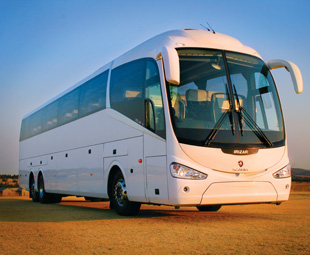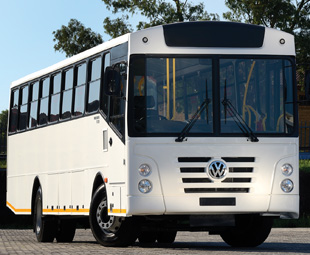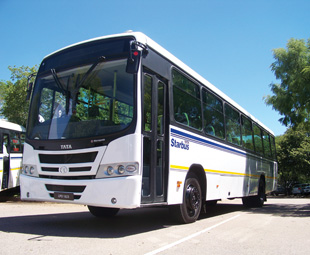Tender times

What can the bus and coach industry expect in 2013, and did market predictions for 2012 hold water? BLAIR BURMEISTER speaks to those in the know
South Africa’s bus and coach industry didn’t fare as well as expected last year. Many industry players predicted that 2012 would see some much-needed growth after a stagnant 2011, but only a slight improvement was recorded.
The market has shown few signs of significant growth from the drop in sales in 2011, with the large bus market growing to 1 071 units in 2012 from the low of 986 units in 2011, according to the National Association of Automobile Manufacturers of South Africa (Naamsa). There has, however, been a sense of organic entry-level growth, which ultimately bodes well going into 2013.
“There has been a gradual sense of recovery, with 2012 reflecting an average bus sales record,” says Volvo Southern Africa Bus Division GM Marius Botha. He says it was a good but tough year.
Botha feels the market will remain tough in 2013, but will also bring about opportunities for sustainable growth: “Potential fleet expansions, municipal fleet renewals and bus rapid transit (BRT) tender awards can contribute to a strong market for the next two or three years.”
Bus market leader, MAN Truck & Bus South Africa, has a 46 percent share of the large bus market and saw an increase in sales from 2011. Although the company is top of the ranks, Sales Region Middle East and Africa CEO Markus Geyer says the market will remain tough and competitive for South Africa in 2013.
 Ray Karshagen, MAN Truck & Bus South Africa joint CEO, agrees that 2012 was quite tough for the bus business: “But we expected it after the height of 2009 and the 2010 Soccer World Cup.”
Ray Karshagen, MAN Truck & Bus South Africa joint CEO, agrees that 2012 was quite tough for the bus business: “But we expected it after the height of 2009 and the 2010 Soccer World Cup.”
He adds: “We forecast that there will be some growth based on tender business around the BRT systems that are being introduced around the country.”
Last year, the progress from local municipalities on following through with BRT tenders and contracts was slow. But Karshagen is confident that we can expect to see some major investments in the bus industry in 2013.
He notes that the City of Johannesburg has indicated that it wants more than 130 buses for its Rea Vaya BRT system, with Cape Town hoping to secure more than 100 buses for its MyCiti public transport network. Tshwane is due to issue a tender for buses for its new BRT network in February.
“Our major feat is that we have kept investing despite the uncertainty of the future of the subsidy system,” says Karshagen. “We believe that in 2013, government will negotiate contracts. The prospects for the future look good.”
He reveals that the Department of Transport has just launched the South African National Small Bus Operators’ Council; an elected national body that will represent all small bus operators in the various provinces (about 15 percent of all bus fleet operators in the country).
Karshagen believes it to be a fantastic initiative. “It will give small bus operators a chance to enter the market, and empower them going into 2013.”
Botha reveals that Volvo is looking forward to participating in the Rustenburg rapid transit tender, but says the company is still waiting for announcements about the Rea Vaya and City of Cape Town BRT tenders.
Scania Bus and Coach South Africa is in the same boat. “Sales could pick up substantially with all the tenders pending,” says Roberto Virgili, national sales manager for Scania Bus and Coach South Africa. He believes offering clients financial packages will be another crucial aspect if the market is to grow in 2013.
“We believe 2013 will be very similar to last year,” explains Virgili. “A lot will depend on the world and South African economies. If there is an improvement, this will have a positive impact on the bus and coach industry. If it remains the same as 2012 or worse, sales will drop.”
He does, however, see the development of BRT systems as an opportunity to improve market development in 2013. “We will have to wait and see as there are a number of BRT tenders hanging in the air – we are all waiting to see who is awarded them.”
Eric Cornelius, executive manager of the Southern African Bus Operators Association (SABOA), says BRT progress and development was substantially slow in 2012. “BRT systems seem to be more expensive than anticipated by government, and there is an indication that government will re-think its strategy in this regard. Progress has been slow and we don’t expect it to change in 2013.”
The indecisiveness and thus slow progress related to subsidies and contracts is causing a lot of uncertainty in the bus industry. According to Cornelius, bus operators have been on month-to-month contracts for the past 10 years. It’s difficult for operators to continue investing in their fleets not knowing whether they will have contracts the following month.
“In many instances, the authorities don’t honour their contracts in terms of paying operators on time or applying the escalation provided for in these contracts,” he says. SABOA is having its upcoming strategic planning workshop to identify its focus areas for 2013, and Cornelius says there is no doubt that lobbying government on policy issues will be a focus area for 2013.
There appears to be a definite willingness on the side of the authorities to improve transport networks around the country, but the actual follow through on tenders is slow. Some would say that this is one of the main reasons for the poor performance of the bus industry.
Steven Sutherland, MiX Telematics sales director for Africa and South Africa, says the company will put a lot of focus on the public transport space in 2013 and the next few years. “The bus and coach industry is a principle strategic focus segment for us. We see the public transport sector as one of the key market segments which will contribute towards our strategic growth intentions for 2013.”
He adds: “With issues such as highway tolling, public transport has to become a cost-effective and viable option for the public. We would like to add to improving the image of public transport as it is something we have the ability to change.”
Sutherland, who is also involved in global operations, says the company would like to use its experience dealing with and providing smart technology to public transport sectors internationally to improve the cost-effectiveness and efficiency of public transport in South Africa.
“We would like to bring what we have learned internationally to South Africa,” adds Sutherland. He explains that in 2013, MiX will tailor its offerings to suit public transport. “Smart technology that caters for route adherence and integration between telematics and ticketing systems for improved cost effectiveness are all part of the plan to improve the passenger’s perception of public transport in
South Africa.”
 Sutherland, although speaking as a service provider, tells FOCUS what he would really like to see from the industry in 2013: “Improved interaction from and between all role players in the public transport sphere. An open interaction from government in combination with improved planning is what we would really like to see.” He feels there is a need for a more proactive approach.
Sutherland, although speaking as a service provider, tells FOCUS what he would really like to see from the industry in 2013: “Improved interaction from and between all role players in the public transport sphere. An open interaction from government in combination with improved planning is what we would really like to see.” He feels there is a need for a more proactive approach.
Transport and related services is a catalyst for economic growth and direct and indirect job creation in South Africa. The provision of affordable, safe and reliable transportation of goods and people is critical to the development of the country.
Government boosted transport infrastructure spending to R66 billion in the 2011/12 financial year and is expected to raise it to R80 billion by 2013/14. The improvements will be rolled out across the country, contributing to the creation of jobs and tourism opportunities.
Over the next three years, an additional R2,5 billion will be allocated to municipalities for public transport systems and infrastructure – we can only hope that 2013 will be a year of improved activity with the issuing of tenders as BRT contracts have a huge impact on bus sales. This could provide the bus industry with the boost it needs.
Despite a tough year, industry players remain positive going forward. “The long-term outlook remains positive,” says Cornelius. “There will always be a need to transport people, but the state of the South African economy and level of employment will play an important role in the well-being of the industry.”
For the coach industry, which is largely dependant on tourism, the state of the world economy in 2013 will play a big role in the wellbeing of production and sales. “The last few years have been difficult due to the worldwide economic downturn,” says Cornelius.
Times have certainly been tough for the semi-luxury and luxury coach market. “Sales have been significantly lower in this segment compared to previous years,” notes Irizar Southern Africa GM Paul Nel.
According to Nel, the challenges in the world economy and the impact of this on exchange rates will continue to affect the luxury market. He notes that low sales volumes in 2011 presented challenges for 2012: “It was indeed a challenge for Irizar. However, good strategic decisions in years prior to this allowed the company to stand strong.”
Political uncertainty coupled with difficult financial times in Europe has had an effect on luxury coach acquisitions, and will continue to.
“The financial world needs to recover, then people will want to travel,” adds Nel. “The big question is when this process will actually start. South Africa is still seen as a fantastic destination, but we need to start seeing the large and regular tourist groups.”
Despite a lack of encouragement and excitement about increased sales volumes, Nel remains upbeat about the year ahead. “We expect a very similar year to last year. However, a stable country with a slightly stronger rand against the dollar could definitely help.”
It’s not all doom and gloom for the luxury coach market. For Irizar, the i6 launched in mid-2012 was well received locally and has recorded good sales. Despite tough conditions, Irizar will continue to invest in southern Africa: “We will support the local industry to the best of our ability,” says Nel.
Overall, 2012 appears to have been a period of mixed achievements for the bus and coach industry. The substantial growth that was hoped for at the end of 2011 did not materialise but the industry and its players are positive going forward. Gradual growth is, however, better than a decline and hopefully we will see a stable economy in 2013 with increased activity from all role players.
Published by
Focus on Transport
focusmagsa





 FUSO: Driving the Future of Mobile Healthc
FUSO: Driving the Future of Mobile Healthc



 New Electric Van Range Unveiled!
New Electric Van Range Unveiled!  A brand
A brand




 Wondering about the maximum legal load for a
Wondering about the maximum legal load for a 
 The MAN hTGX powered by a hydrogen combus
The MAN hTGX powered by a hydrogen combus


 Exciting News for South African Operators
Exciting News for South African Operators






